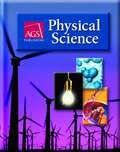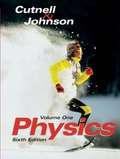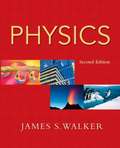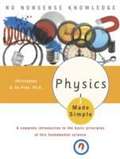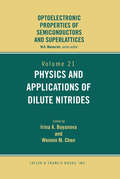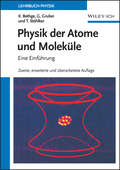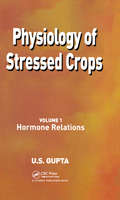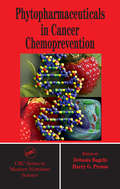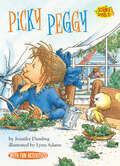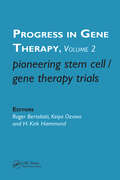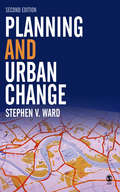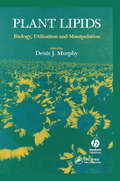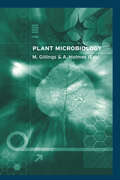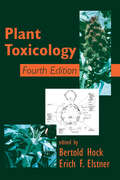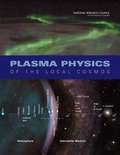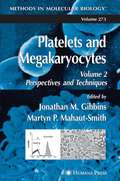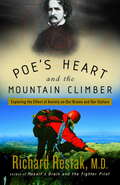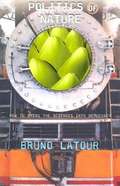- Table View
- List View
Physical Science
by Barbara Ferrier Timothy EimerLearn all about matter, energy, electricity and magnetism in this book.
Physical Science
by Donald H. Jacobs Robert H. MarshallPhysical Science text, students learn the properties of matter, elements, compounds, electricity, and sound and light. Students reading significantly below grade level gain practice in working with data and sharpen their abilities to infer, classify, and theorize. Lexile Level 840 Reading Level 3-4 Interest Level 6-12 Features and Benefits Aligns with NCTM Standards ELL/ESL appropriate Track student progress with Skill Track Software Concepts presented in clear, simple language Problem solving and word problems encourage students to relate skills to real-life situations Relevant practice activities such as comparison shopping and figuring interest rates Supplemental problems for additional practice and review Calculator activities reinforce computation skills Over 300 additional activities available on the Teacherâ s Resource Library CD-ROM Research and Validity AGS Globe publishes high-interest, low-reading level textbooks, instructional materials, and assessments for students with a wide range of special needs. The purpose of this report is to document how AGS Globe textbooks are aligned with scientific research that supports best practices in pedagogy, instructional design, and instructional techniques.
Physical Science: Concepts in Action, With Earth and Space Science
by Michael Wysession Sophia Yancopoulos David V. FrankPhysical Science is the study of non-living systems, as opposed to a study of biological sciences or living systems. It consists of physics, chemistry, astronomy and earth science. It also includes scientific method and experimentation and this is what this textbook is all about.
Physics (6th Edition)
by John D. Cutnell Kenneth W. JohnsonThis Sixth Edition helps readers understand the interrelationships among basic physics concepts and how they fit together to describe our physical world. Throughout the book, the authors emphasize the relevance of physics to our everyday lives. Real-world physics applications, including many biomedical applications, show how physics principles come into play over and over again in our lives. Problem Solving Insights explain each calculation in detail, guiding readers through the quantitative process Includes a CD containing physics simulations
Physics (Second Edition)
by James S. WalkerThis introduction to algebra-based physics covers the full spectrum of topics in Mechanics, Thermal Physics, Electromagnetism, Light and Optics, and Modern Physics.
Physics Made Simple
by Christopher Gordon De PreeUnderstand the rules that make the universe run. Understanding the laws of physics is essential for all scientific studies, but many students are intimidated by their complexities. This completely revised and updated book makes it easy to understand the most important principles. From the physics of the everyday world to the theory of relativity, PHYSICS MADE SIMPLE covers it all. Each chapter is introduced by anecdotes that directly apply the concepts to contemporary life and ends with practice problems--with complete solutions--to reinforce the concepts. Humorous illustrations and stories complete the text, making it not only easy but fun to learn this important science. Topics covered include: *force *motion *energy *waves *electricity and magnetism *the atom *quantum physics *relativity *spectroscopy *particle physics.
Physics and Applications of Dilute Nitrides
by Irina A. Buyanova Weimin M. ChenSince their development in the 1990s, it has been discovered that diluted nitrides have intriguing properties that are not only distinct from those of conventional semiconductor materials, but also are conducive to various applications in optoelectronics and photonics. The book examines these applications and presents a broad and in-depth look at t
Physik der Atome und Moleküle: Eine Einführung
by Klaus Bethge Thomas Stöhlker Gernot GruberDie Autoren präsentieren eine integrierte Darstellung von Atom- und Molekülphysik. Neben grundlegenden Themen wie Quantenmechanik und Statistik behandeln sie auch neuere Anwendungen, z.B. die Hochpräzisionsspektroskopie. Das bewährte didaktische Konzept der Vorauflage wurde beibehalten. Inhaltlich wurde der Band vollständig überarbeitet und aktualisiert, eine ganze Reihe neuer Kapitel sind hinzugekommen. Dass Atom- und Molekülphysik eng miteinander vernetzt sind, ist bekannt. Diese Einsicht in einem Lehrbuch umzusetzen, war das Anliegen der Autoren, als sie sich an die Arbeit zur ersten Auflage dieses Bandes machten. Und der Erfolg gab ihnen Recht. Nun liegt ihr Werk in einer völlig überarbeiten und aktualisierten Neuauflage vor. Der Band verbindet die Vermittlung von Grundlagenwissen mit der Darstellung modernster Methoden und Anwendungen. So kann sich der Leser nicht nur die "Basics" etwa in Quantenmechanik und Statistik aneignen. Denn in den neuen Kapiteln finden sich nun auch die jüngsten Erkenntnisse aus der Quantenoptik, zu Atom- und Ionenfallen, Atomen in starken Magnetfeldern und aus der Hochpräzisions-spek-troskopie. Auch die Geheimnisse der Bose-Einstein-Kondensate werden gelüftet. Am erfolgreichen didaktischen Konzept der ersten Auflage wurde nichts geändert. Alle Herleitungen werden ausführlich erklärt und durchgerechnet, schwierige Gedankengänge und komplizierte Rechnungen werden Schritt für Schritt erläutert.
Physiology and Biotechnology Integration for Plant Breeding (Books In Soils, Plants, And The Environment Ser. #Vol. 100)
by Abraham Blum Henry T. Nguyen� Global demand for wheat, rice, corn, and other essential grains is expected to steadily rise over the next twenty years. Meeting this demand by increasing production through increased land use is not very likely; and while better crop management may make a marginal difference, most agriculture experts agree that this anticipated deficit must be m
Physiology of Stressed Crops, Vol. 1: Hormone Relations
by U S GuptaThe present multi-volume treatise has been planned to discuss important aspects of the crop-plant physiological aspects, viz., hormones, nutrients, cell membranes, and induced proteins, as related to different types of stresses each in separate volumes. Another type of stress which can be classed under biotic, environmental (sil) or chemical, viz., the stress of allelochemicals which has not been discussed before as a stress factor, will be discussed in a separate volume emphasizing its practical/ ap-plied aspects, rather than mentioning only the allelopathic effects. In this volume on Hormone Relations, different stresses have been arranged in order of their importance and work done.
Phytochemicals in Health and Disease (Oxidative Stress And Disease Ser. #Vol. 12)
by Yongping Bao Roger Fenwick"� well-written and the content is clearly presented. � There are plentiful figures and tables, which are effectively labeled and adequately support the content. �highly recommended for academic and special libraries. �effectively presents current research on phytochemicals in a readable manner."- E-Streams "This landmark volume shows h
Phytopharmaceuticals in Cancer Chemoprevention
by Harry G. Preuss Debasis BagchiDuring the past decade, a significant amount of research has been conducted on phytopharmaceuticals. Today, a growing body of evidence demonstrates the efficacy of a wide variety of natural products and affirms their potential in the treatment of cancer. Phytopharmaceuticals in Cancer Chemoprevention focuses on the role of natural supplemen
Picky Peggy (Science Solves It!)
by Jennifer DusslingSolve kid-sized dilemmas and mysteries with the Science Solves It! series. These fun books for kids ages 5–8 blend clever stories with real-life science. Why did the dog turn green? Can you control a hiccup? Is that a UFO? Find the answers to these questions and more as kid characters dive into physical, life, and earth sciences. When Mr. Cooper gives Peggy a new baby duck, she promises to take good care of it. But when Fluff's feathers begin to droop and his eyes are no longer bright and shiny, Peggy discovers why and learns that good nutrition is very important - for growing ducks and growing girls! Books in this perfect STEM series will help kids think like scientists and get ahead in the classroom. Activities and experiments are included in every book! (Level One; Science topic: Nutrition)
Pioneering Stem Cell/Gene Therapy Trials
by Roger Bertolotti Keiyo Ozawa H. Kirk HammondThe first unequivocal success for Gene Therapy was reported in April 2000 for X-SCID patients. Pioneering stem cell/gene therapy clinical trials are the focus of this book. Therapy successes such as the X-SCID trial and improved ADA-SCID ones are presented together with pioneering angio/vasculogenic clinical trials mediated either by transient gene therapy or emerging autologous stem cell transplantation. Highlights also include 1) promises of the breakthrough combination of stem cell- and transient gene-therapy, 2) gene therapy trials for neurodegenerative disease on non-human primates where long-term gene therapy might involve brain stem cells, and 3) the first clinical trial with non-invasive monitoring of therapeutic gene expression as a prospective conclusion.
Planning and Urban Change (Urban And Regional Development Ser.)
by Stephen V. WardFully revised and thoroughly updated, the Second Edition of Planning and Urban Change provides an accessible yet richly detailed account of British urban planning. Stephen Ward demonstrates how urban planning can be understood through three categories: ideas - urban planning history as the development of theoretical approaches: from radical and utopian beginnings, to the `new right' thinking of the 1980s, and recent interest in green thought and sustainability; policies - urban planning history as an intensely political process, the text explains the complicated relation between planning theory and political practice; and impacts - urban planning history as the divergence of expectation and outcome, each chapter shows how intended impacts have been modified by economic and social forces. This Second Edition features an entirely new chapter on the key policy changes that have occurred under the Major and Blair governments, together with a critical review of current policy trends.
Plant Lipids: Biology, Utilisation and Manipulation (Biological Sciences Ser.)
by Denis J. MurphyNew research tools have revealed many surprising aspects of the dynamic nature of lipids and their participation in processes such as recognition, intra- and inter-cellular signalling, deterrence and defense against pathogens, membrane trafficking and protein function. This is in addition to new information on the more established roles of plant lipids as structural components of membranes and as long-term storage products. Plant lipids are also increasingly being seen as sources of a new generation of environmentally friendly, biodegradable, and renewable industrial products, including biopolymers and high-grade lubricants.Plant Lipids: Biology, Utilisation and Manipulation provides a broad overview of plant lipid research and its many applications. Linking various disciplines, the editor brings together researchers from major international laboratories to review the history and current state of progress in this quickly evolving field. The text starts by providing a fascinating historical perspective on the study of plant lipids, from its inception as a branch of alchemy in the seventeenth century to the current post-genomic era. It then offers a detailed discussion on the formation, modification and utilization of fatty acids. This is followed by an exploration of the major classes of macromolecular structures formed by plant lipids, including bilayer membranes and storage bodies. From there, the contributors consider other types of macromolecular lipid assemblies in plants, examining proteins and the key plant lipid structure - the cuticle. The final chapters look at diverse classes of plant lipids that are linked to various aspects of signaling. This text provides an excellent resource for researchers and professionals in plant biochemistry, molecular biology, biotechnology and genetics, in both the academic and industrial sectors. It also meets the needs of students looking for a comprehensive introduction to this field, as well as direction for fut
Plant Microbiology
by Andrew Holmes Michael GillingsPlant Microbiology provides a comprehensive source of information on DNA sequencing and mapping, the newest technology and procedures in areas such as radiation hybrid mapping, FISH and specialized sequencing techniques are covered. The book also describes how transgene expression is controlled in plants and how advanced information strategies can be used to manipulate and modify the plant genome. An exciting final chapter provides and overview of all the applications of plant transformation in agriculture, medicine and industry.
Plant Toxicology
by Bertold Hock Erich F. ElstnerIn order to keep track of all the compounds and pathogens affecting plant metabolism and development, you would need to spend all your waking hours combing periodicals and the Internet in dozens of languages, as new toxins via pollutants and migratory or mutant pathogens are being discovered every day. Plant Toxicology, Fourth Edition start
Plasma Physics of the Local Cosmos
by Committee on Solar Space PhysicsSolar and space physics is the study of solar system phenomena that occur in the plasma state. Examples include sunspots, the solar wind, planetary magnetospheres, radiation belts, and the aurora. While each is a distinct phenomenon, there are commonalities among them. To help define and systematize these universal aspects of the field of space physics, the National Research Council was asked by NASA’s Office of Space Science to provide a scientific assessment and strategy for the study of magnetized plasmas in the solar system. This report presents that assessment. It covers a number of important research goals for solar and space physics. The report is complementary to the NRC report, The Sun to the Earth—and Beyond: A Decadal Research Strategy for Solar and Space Physics, which presents priorities and strategies for future program activities.
Platelets and Megakaryocytes, Volume 1: Functional Assays
by Martyn P. Mahaut-Smith Jonathan M. GibbinsPlatelets are an essential element of the body's hemostasis system, and yet, through their involvement in thrombosis, are also a major cause of morbidity and mortality. Platelets have a limited lifespan and must be continually manufactured by their precursor, the megakaryocyte. In Platelets and Megakaryocytes, Volume 1: Functional Assays, leading expert researchers-many responsible for seminal discoveries in the field-describe basic and advanced techniques for analyzing platelet and megakaryocyte function in step-by-step detail. The approaches presented for platelet analysis include aggregometry, secretion, arachidonic acid metabolism, procoagulent response, platelet adhesion under static and flow conditions, flow cytometry, and production of microparticles. Techniques presented for megakaryocyte function research include those used to study the development of specialized structures for platelet production, the appearance of platelet-specific surface receptors, and the increase in ploidy. All protocols follow the successful Methods in Molecular Biology™ series format, each one offering step-by-step laboratory instructions, an introduction outlining the principle behind the technique, lists of equipment and reagents, and tips on troubleshooting and avoiding known pitfalls. A companion volume, Platelets and Megakaryocytes, Volume 2: Perspectives and Techniques offers a state-of-the-art survey of our understanding of these cells, with emphasis on the role of cell signaling in their regulation and function, as well as the use of molecular and post-genomic techniques for their study.<P><P> Comprehensive and cutting-edge, the two volumes of Platelets and Megakaryocytes offer novice and experienced cell biologists, hematologists, and clinicians not only a benchmark survey of the field, but also a comprehensive library of proven techniques essential for productive research on platelets and megakaryocytes today.
Platelets and Megakaryocytes, Volume 2: Perspectives and Techniques
by Martyn P. Mahaut-Smith Jonathan M. GibbinsPlatelets are an essential element of the body's hemostasis system, and yet, through their involvement in thrombosis, are also a major cause of morbidity and mortality. Platelets have a limited lifespan and must be continually manufactured by their precursor, the megakaryocyte. In Platelets and Megakaryocytes, Volume 2: Perspectives and Techniques leading expert researchers-many responsible for seminal discoveries in the field-offer basic and advanced techniques for studying cell signaling in the regulation and function of platelets and megakaryocytes, as well as state-of-the-art commentaries on our understanding of these cells. The methods include ligand-binding assays, the study of protein and lipid kinases and phosphatases, the analysis of lipid rafts in the regulation of cell signaling, and the measurement of intracellular calcium levels. There are also techniques for the study of electrophysiological events, nitric oxide signaling, venom proteins, and for the internalization of proteins into platelets through permeabilization. The application of many molecular and post-genomic methods to the study of platelets and megakaryocytes is also described. All protocols follow the successful Methods in Molecular Biology™ series format, each one offering step-by-step laboratory instructions, an introduction outlining the principle behind the technique, lists of equipment and reagents, and tips on troubleshooting and avoiding known pitfalls. A companion volume, Platelets and Megakaryocytes, Volume 1: Functional Assays describes in step-by-step detail basic and advanced techniques for analyzing platelet and megakaryocyte function. <P><P> Comprehensive and cutting-edge, the two volumes of Platelets and Megakaryocytes offer novice and experienced cell biologists, hematologists, and clinicians not only a benchmark survey of the field, but also a comprehensive library of proven techniques essential for productive research on platelets and megakaryocytes today.
Poe's Heart and The Mountain Climber: Exploring The Effect of Anxiety on Our Brains and Our Culture
by Richard RestakAre you bombarded by a constant media feed of global terrorism, war, and rising unemployment rates—and by a mind-numbing array of ads that urge you to “ask your doctor” about the newest anti-anxiety medications? If it sometimes feels as if this country is having a collective anxiety attack, then you won’t be surprised to learn that more than 19 million Americans suffer from some form of acute anxiety. Poe’s Heart and the Mountain Climber tackles this situation head-on, with a fresh perspective and a straightforward approach to exploring and understanding our anxiety before it paralyzes us. After interviewing many experts on anxiety, and reflecting on his own many years treating anxious patients (as well as experiencing more than a few anxious moments himself), Dr. Richard Restak has organized this book around one primary principal: the best way to manage anxiety in these anxious times is to learn about it and put that learning to practical use. His message is vital and empowering: anxiety is not a mental illness that must require medication, but often a normal, biological response to stress. Anxiety is part of our genetic makeup. We wouldn’t be alive today if our ancestors had lacked the ability to anticipate dangers and threats. Anxiety is as natural a part of our existence as breathing, eating, or sleeping, and it is closely linked to our powers of reasoning. Unlike any other species, only we are able to envision future possibilities. As a result, we aren’t tethered to the here and now, but can imaginatively anticipate the good things that might happen to us. But we can also envision the bad things and, as a result, experience anxiety. We can’t have one without the other. Anxiety, therefore, isn’t something to be eliminated but, rather, something to be understood. Anxiety is only undesirable when it becomes extreme. This groundbreaking book teaches us to view anxiety not as a burden, but as a stimulus for greater accomplishment and enhanced self-knowledge. We will function at our best when we stop working to deny our anxiety or trying to escape it and instead learn to accept its presence in our lives and transform it into the positive, creative energy from which it stems.
Polar Explorers for Kids: Historic Expeditions to the Arctic and Antarctic with 21 Activities (For Kids series)
by Maxine SnowdenHeroism and horror abound in these true stories of 16 great explorers who journeyed to the Arctic and Antarctic regions, two exquisite and unique ice wildernesses. Recounted are the exciting North Pole adventures of Erik the Red in 982 and the elusive searches for the "Northwest Passage" and "Farthest North" of Henry Hudson, Fridtjof Nansen, Fredrick Cook, and Robert Peary. Coverage of the South Pole begins with Captain Cook in 1772; continues through the era of land grabbing and the race to reach the Pole with James Clark Ross, Roald Amundsen, Robert Scott, and Ernest Shackleton; and ends with an examination of the scientists at work there today. Astounding photographs and journal entries, sidebars on the Inuit and polar animals, and engaging activities bring the harrowing expeditions to life. Activities include making a Viking compass, building a model igloo, making a cross staff to measure latitude, creating a barometer, making pemmican, and writing a newspaper like William Parry's "Winter Chronicle." The North and South Poles become exciting routes to learning about science, geography, and history.
Politics of Nature: How to Bring the Sciences into Democracy
by Bruno Latour Catherine PorterA major work by one of the more innovative thinkers of our time, Politics of Nature does nothing less than establish the conceptual context for political ecology--transplanting the terms of ecology into more fertile philosophical soil than its proponents have thus far envisioned. Bruno Latour announces his project dramatically: "Political ecology has nothing whatsoever to do with nature, this jumble of Greek philosophy, French Cartesianism and American parks. " Nature, he asserts, far from being an obvious domain of reality, is a way of assembling political order without due process. Thus, his book proposes an end to the old dichotomy between nature and society--and the constitution, in its place, of a collective, a community incorporating humans and nonhumans and building on the experiences of the sciences as they are actually practiced. In a critique of the distinction between fact and value, Latour suggests a redescription of the type of political philosophy implicated in such a "commonsense" division--which here reveals itself as distinctly uncommonsensical and in fact fatal to democracy and to a healthy development of the sciences. Moving beyond the modernist institutions of "mononaturalism" and "multiculturalism," Latour develops the idea of "multinaturalism," a complex collectivity determined not by outside experts claiming absolute reason but by "diplomats" who are flexible and open to experimentation.

